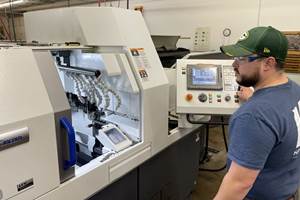Automating Time Studies
This company has created a system that replaces the stopwatch and clipboard system of time study and the manual data transfer and analysis process.
Share






Time studies have pretty much been done the same way since the late 1800s. Back then, time and methods engineering pioneer Frederick Taylor first used a stopwatch and paper to time and record various operations in a Philadelphia steel mill. The simple idea was, and still is, to standardize and thereby optimize operations within the manufacturing environment.
If Mr. Taylor were to come back and perform time studies today, he would feel very much at home. With the possible addition of a clipboard, to aid data recording, the tools of the time study trade—stopwatch and paper—have been virtually unchanged in more than a century.
Once the observations from the time study are recorded, the next step in the traditional process is to transfer the information to a usable format. Historically this is a manual process of transferring the raw time study data into a chronological and readable form. Human error is of high potential during this phase of the process.
With the data transferred, analysis begins. This consists of integrating the information from the time study in sequence charts, graphs, diagrams, flow charts, descriptions and analyses in order to identify problems and recommend changes to the process.
Advanced Time Studies, a Washington company, has created a system that replaces the stopwatch and clipboard system of time study and the manual data transfer and analysis process. The new program is called AccuStudy.
AccuStudy is a software program developed to run on a variety of handheld, touch screen computers. Many of these computers are ideally suited for industrial environments and use Microsoft CE as the operating system. The handheld shown in this article is the PenCentra 200 from Fujitsu.
In operation, the software allows the time studier to identify an icon on the handheld computer screen and touch it while continuing observations for the next process step. Eliminating the need to read the watch and record the time allows studies of close elements without the need to observe numerous iterations to get the times. Sequentially observed timed data can be entered to 1-second accuracy.
The software is able to store as few as one or as many as 10,000 processes or components. Based on the icon system, corresponding value and non-value ratings are automatically entered into the data bank with the observed time.
Once the raw data is gathered, the software is able to provide "instant" analysis of the process from beginning to end. Output is generated into sequential order and then into familiar and useful charts, graphs, descriptions and reports that help identify areas of opportunity for process optimization. These include Gantt, value/non-value activity, choke points in the process, averaging and ISO 9000 method worksheets.
Automating the time study process compresses the turn around of information within the manufacturing enterprise. Problems can be fixed in hours rather than weeks.
Moreover, data gathered from the shop floor can also impact the accurate costing of quotation for additional work. Compressing this bidding process is increasingly important to shops, especially in the current manufacturing environment.
Related Content
6 Machine Shop Essentials to Stay Competitive
If you want to streamline production and be competitive in the industry, you will need far more than a standard three-axis CNC mill or two-axis CNC lathe and a few measuring tools.
Read MoreHow a Custom ERP System Drives Automation in Large-Format Machining
Part of Major Tool’s 52,000 square-foot building expansion includes the installation of this new Waldrich Coburg Taurus 30 vertical machining center.
Read MoreRefining Shopfloor Processes for Mission-Critical Parts
Pacon Mfg, Inc. has not rested on its laurels as the 2020 Top Shop Honoree for Shopfloor Practices and Performance. In the years since, it has refined its processes to continue excelling in a volatile market.
Read MoreERP Provides Smooth Pathway to Data Security
With the CMMC data security standards looming, machine shops serving the defense industry can turn to ERP to keep business moving.
Read MoreRead Next
Machine Shop MBA
Making Chips and Modern Machine Shop are teaming up for a new podcast series called Machine Shop MBA—designed to help manufacturers measure their success against the industry’s best. Through the lens of the Top Shops benchmarking program, the series explores the KPIs that set high-performing shops apart, from machine utilization and first-pass yield to employee engagement and revenue per employee.
Read MoreAMRs Are Moving Into Manufacturing: 4 Considerations for Implementation
AMRs can provide a flexible, easy-to-use automation platform so long as manufacturers choose a suitable task and prepare their facilities.
Read More




















